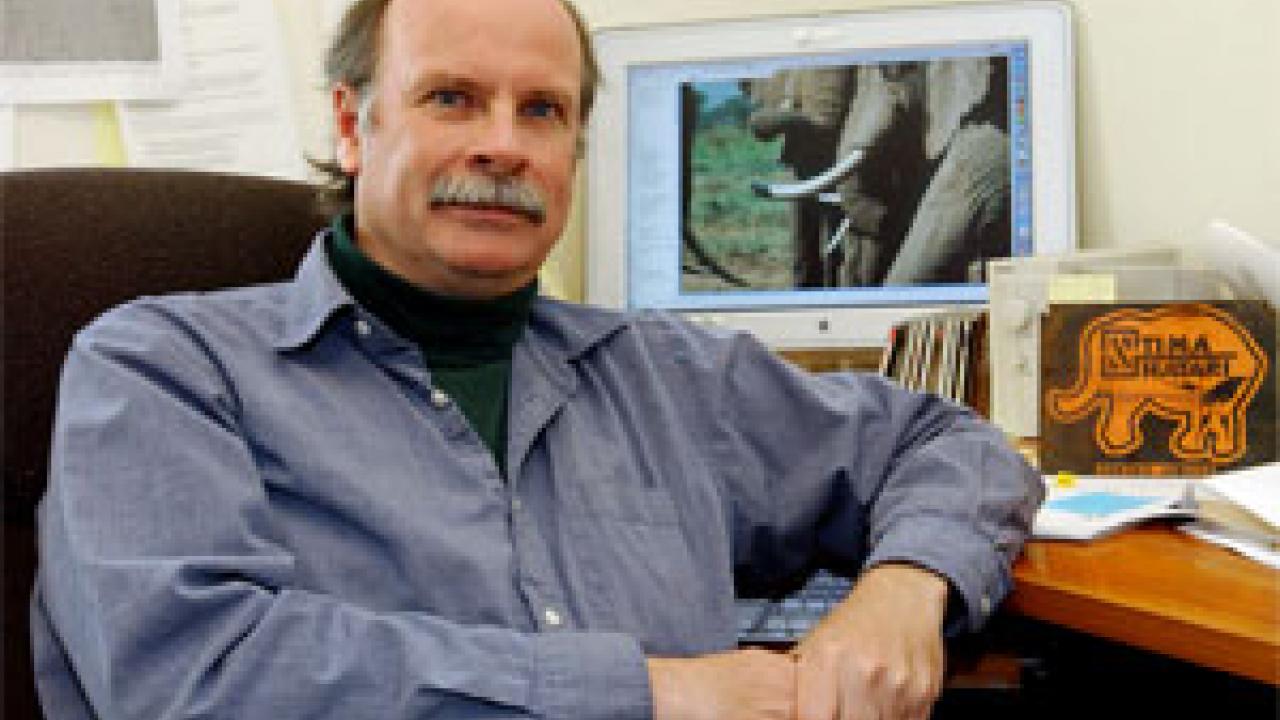Truman Young's habitual work posture — cross-legged and shoeless, with his ergonomic office chair tipped back at a jaunty angle — would challenge the flexibility of the most limber graduate student.
But the tenured environmental horticulture professor's flexibility is a good thing. As the principal investigator on an ambitious study of African grassland ecology, adaptation is his bailiwick. His team manipulates interactions between the species that shape a semi-arid grassland ecosystem in Laikipia, Kenya. Their project, now entering its second decade, is uncovering many surprises about how the ecosystem works. The National Science Foundation recently awarded Young and his team a five-year, $300,000 renewal for their long-term ecological research.
Such research is needed because almost all the world's cattle live on open ranges, interacting with wildlife. "There are profound livestock-wildlife relationships in Africa, and also in places like Australia, Nevada and California," Young said.
The grasslands of Kenya are a long way from the mountains of Young's native Colorado. Indeed, as a graduate student, he wanted to study Colorado's alpine ecology. Instead, a research grant led him to the alpine regions of Kenya to investigate giant lobelia plants. "I thought I'd get a quick doctorate and go back to Colorado," he says, "but I got connected to the ecosystems of Kenya and haven't left."
The connection is so strong, he says, that "if I had my choice, I'd live in a tent in Laikipia." At the beginning of his current research program, he and his wife, behavioral ecologist and now UC Davis anthropology professor Lynne Isbell, spent many months in a tented camp on the Kenyan savannah. "It was by far the best time we've had in our lives," he says.
Their camp of 16-foot-by-20-foot tents had a few creature comforts: solar cells to provide 24-hour electricity; a hot shower system contrived from a bucket and pulley; a small wooden building containing the camp kitchen. But it is the closeness to the natural world that Young remembers best. "Living there, I always knew the phase of the moon," he says. "In Davis, I rarely know it."
Today, the area around the original tented camp has been transformed into the Mpala Research Centre, the site of Young's ongoing, long-term research project. His team of scientists is focused on how Kenya's grasslands are affected by animals such as elephants, zebras and domestic cattle.
"It is well known that large herbivores are important for their ecosystems," he says.
"But we're the first to do experiments using independent manipulations of both wild mammals and livestock."
To examine the relationships between wild mammals and livestock, the research team built a set of large fenced areas on Kenyan pasture lands to control the movement of animals. The plots vary. Some are closed off to all big herbivores; others can be grazed only by cattle, only by wild herbivores, or by combinations of cattle and wildlife. Some areas are "fenced" with a single charged wire high above the ground to exclude elephants and giraffes.
Using a combination of dung counts and measures of vegetation, the team evaluates how much each wildlife species use each plot, and what plants they have eaten. The scientists also observe grazing cattle directly, measuring "bite rates" by counting how many bites (and steps) foraging cattle take in a certain period of time.
Grazing habits show all plants are not created equal
It turns out that the ecological relationships in this system are more complex than anyone assumed. One "weird twist," Young says, is that when cattle graze areas where elephants have been, they eat more slowly than usual, and leave more grass behind. He thinks this is because elephants selectively eat forbs — non-grassy plants — which have a higher protein content than grass. Slow-grazing cattle may be searching for forbs to meet their protein needs.
Relationships between cattle and zebras are similarly complex. Kenyan ranchers say "every zebra costs you two cattle" because they say each zebra eats about as much as two cattle. But Young's team has found no evidence of such a value. When cattle are removed from the land, zebra presence does increase, but they do not reduce vegetation to the levels seen when cattle are present.
And small herbivores make the picture even more complicated. Take away all the big plant-eaters, and half of the vegetation still disappears, nibbled by rodents. "This means that getting rid of zebras doesn't get you all of that grass for cattle," Young points out.
As it becomes more difficult to make a living raising cattle, East African ranchers and pastoralists must carefully consider the costs and benefits of wildlife.
Their lives have always been shaped by wild creatures. For example, African pastoralists keep cattle together in large, supervised herds to protect them from predators such as lions. "It used to be that they would tolerate wildlife because it was hard to get rid of it," Young says.
Now it is possible to eliminate wildlife from rangelands, as some large landowners have done. But at the same time, Young says, "the value of wildlife is increasing, both economically and societally." Wild animals bring tourism dollars, and efforts are afoot to incorporate wildlife into ranching economies.
"Many Kenyans now want 'just enough' wildlife," he says. "Both private landowners and governments want to find the right balance."
Media Resources
Amy Agronis, Dateline, (530) 752-1932, abagronis@ucdavis.edu
